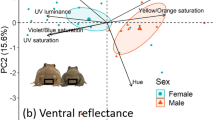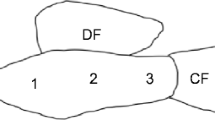Abstract
The role of ultraviolet (UV) signals in intraspecific communication has been identified in a number of vertebrate taxa. In lizards, the signalling role of UV has only been shown in male–male competition and male mate choice. Here, we investigated whether male UV colour can be a basis of female association preference in European green lizards (Lacerta viridis), a species where males develop blue nuptial throat colouration with high UV reflectance. We experimentally manipulated the UV colour of male pairs, where the members of the pair did not differ significantly in body length, body weight, head size, throat UV chroma and brightness or throat blue chroma and brightness measured prior to colour manipulation. By providing these pairs of males to females (only visual stimuli could be perceived by the females), we assessed the role of UV in female association preference irrespective of other potentially important visual traits. We found that unmated but receptive females preferred males of higher UV reflectance. Our results show for the first time that UV colour can be an important male signal in female preference in reptiles.




Similar content being viewed by others

References
Andersson M (1994) Sexual selection. Princeton University Press, Princeton
Andersson S, Amundsen T (1997) Ultraviolet colour vision and ornamentation in bluethroats. Proc R Soc Lond B 264:1587–1591
Andersson S, Örnborg J, Andersson M (1998) Ultraviolet sexual dimorphism and assortative mating in blue tits. Proc R Soc Lond B 265:445–450
Baird TA, Fox FS, McCoy K (1997) Population differences in the roles of size and coloration in intra- and intersexual selection in the collared lizard, Crotaphytus collaris: influence of habitat and social organization. Behav Ecol 8:506–517
Bennett ATD, Cuthill IC, Partridge JC, Maier EJ (1996) Ultraviolet vision and mate choice in zebra finches. Nature 380:433–435
Bennett ATD, Cuthill IC, Partridge JC, Lunau K (1997) Ultraviolet plumage colors predict mate preferences in starlings. Proc Natl Acad Sci USA 94:8618–8621
Boulcott PD, Walton K, Braithwaite VA (2005) The role of ultraviolet wavelengths in the mate-choice decisions of female three-spined sticklebacks. J Exp Biol 208:1453–1458
Calsbeek R, Sinervo B (2002) Uncoupling direct and indirect components of female choice in the wild. Proc Natl Acad Sci USA 99:14897–14902
Censky EJ (1997) Female mate choice in the non-territorial lizard Ameiva plei (Teiidae). Behav Ecol Sociobiol 40:221–225
Cooper WE Jr, Vitt LJ (1993) Female mate choice of large male broad-headed skinks. Anim Behav 45:683–693
Cuthill IC, Partridge JC, Bennett ATD (2000) Avian UV vision and sexual selection. In: Espmark Y, Amundsen T, Rosenqvist G (eds) Animal signals: signalling and signal design in animal communication. Tapir Academic, Trondheim, pp 61–82
Ellingson JM, Fleishman LJ, Loew ER (1995) Visual pigments and spectral sensitivity of the diurnal gecko Gonatodes albogularis. J Comput Phys 177:559–567
Figuerola J, Senar JC (2005) Seasonal changes in carotenoid- and melanin-based plumage coloration in the great tit Parus major. Ibis 147:797–802
Fitze PS, Le Galliard JF, Federici P, Richard M, Clobert J (2005) Conflict over multiple-partner mating between males and females of the polygynandrous common lizards. Evolution 59:2451–2459
Fleishman LJ, Loew ER, Leal M (1993) Ultraviolet vision in lizards. Nature 365:397
Fleishman LJ, Bowman M, Saunders D, Miller WE, Rury MJ, Loew ER (1997) The visual ecology of Puerto Rican anoline lizards: habitat light and spectral sensitivity. J Comp Physiol A 181:446–460
Font E, de Lanuza GP, Samperdo C (2009) Ultraviolet reflectance and cryptic sexual dichromatism in the ocellated lizard, Lacerta (Timon) lepida (Squamata: Lacertidae). Biol J Linn Soc 97:766–780
Gasc J-P, Cabela A, Crnobrnja-Isailovic J, Dolmen D, Grossenbacher K, Haffner P, Lescure J, Martens H, Martinez Rica JP, Maurin H, Oliveira ME, Sofianidou TS, Veith M, Zuiderwijk A (Eds) (1997) Atlas of amphibians and reptiles in Europe. Societas Europea Herpetologica & Museum National d’Histoire Naturelle (IEGB/SPN), Paris
Hamilton PS, Sullivan BK (2005) Female mate attraction in ornate tree lizards, Urosaurus ornatus: a multivariate analysis. Anim Behav 69:219–224
Hill GE, McGraw KJ (2006) Bird coloration, vol. 1. Mechanisms and measurements. Harvard University Press, Cambridge
Hunt S, Bennett ATD, Cuthill IC, Griffith R (1998) Blue tits are ultraviolet tits. Proc R Soc Lond B 265:451–455
Jawor JM, Breitwisch R (2004) Multiple ornaments in male northern cardinals, Cardinalis cardinalis, as indicators of condition. Ethology 110:113–126
Kemp DJ (2008) Female mating biases for bright ultraviolet iridescence in the butterfly Eurema hecabe (Pieridae). Behav Ecol 19:1–8
Kopena R, López P, Martín J (2009) Lipophilic compounds from the femoral gland secretions of male Hungarian green lizards, Lacerta viridis. Z Naturforsch 64:434–440
Korsten P, Limbourg T, Lessells CM, Komdeur J (2007) Effectiveness of a commonly-used technique for experimentally reducing plumage UV reflectance. J Avian Biol 38:399–403
Kwiatowski MA, Sullivan BK (2002) Geographic variation in sexual selection among populations of an iguanid lizard, Sauromalus obesus (=ater). Evolution 56:2039–2051
LeBas NR, Marshall J (2000) The role of colour in signalling and male choice in the agamid lizard, Ctenophorus ornatus. Proc R Soc Lond B 267:45–452
LeBas NR, Marshall J (2001) No evidence of female mate choice for a condition-dependent trait in the agamid lizard, Ctenophorus ornatus. Behaviour 138:965–980
Li J, Zhang Z, Liu F, Liu Q, Gan W, Chen J, Lim MLM, Li D (2008) UVB-based mate-choice cues used by females of the jumping spider Phintella vittata. Curr Biol 18:699–703
Loew ER, Govardovskii VI, Röhlich P, Szél A (1996) Microspectrophotometric and immunocytochemical identification of ultraviolet photoreceptors in geckos. Vis Neurosci 13:247–256
López P, Martín J (2005a) Chemical compounds from femoral gland secretions of male Iberian rock lizards, Lacerta monticola cyreni. Z Naturforsch 60:632–636
López P, Martín J (2005b) Female Iberian wall lizards prefer male scents that signal a better cell-mediated immune response. Biol Lett 1:404–406
López P, Munoz A, Martín J (2002) Symmetry, male dominance and female mate preferences in the Iberian rock lizard, Lacerta monticola. Behav Ecol Sociobiol 52:342–347
López P, Amo L, Martín J (2006) Reliable signaling by chemical cues of male traits and health state in male lizards, Lacerta monticola. J Chem Ecol 32:473–488
Martín J, Forsman A (1999) Social costs and development of nuptial coloration in male Psammodromus algirus lizards: an experiment. Behav Ecol 10:396–400
Martín J, López P (2008) Female sensory bias may allow honest chemical signalling by male Iberian rock lizards. Behav Ecol Sociobiol 62:1927–1934
Martín J, López P (2009) Multiple color signals may reveal multiple messages in male Schreiber's green lizards, Lacerta schreiberi. Behav Ecol Sociobiol 63:1743–1755
McGraw KJ, Mackillop EA, Dale J, Hauber ME (2002) Different colors reveal different information: how nutritional stress affects the expression of melanin- and structurally based ornamental plumage. J Exp Biol 205:3747–3755
Olsson M (1993) Nuptial coloration and predation risk in a model sand lizards, Lacerta agilis. Anim Behav 46:410–412
Olsson M, Madsen T (1995) Female choice on male quantitative traits in lizards—why is it so rare? Behav Ecol Sociobiol 36:607–613
Olsson M, Madsen T (1998) Sexual selection and sperm competition in reptiles. In: Birkhead TR, Møller AP (eds) Sperm competition and sexual selection. Academic, London
Pearn SM, Bennett AT, Cuthill IC (2001) Ultraviolet vision, fluorescence and mate choice in a parrot, the budgerigar Melopsittacus undulatus. Proc R Soc Lond B 268:2273–2279
Penteriani V, Alonso-Alvarez C, del Mar DM, Sergio F, Ferrer M (2006) Brightness variability in the white badge of the eagle owl Bubo bubo. J Avian Biol 37:110–116
Rick IP, Bakker TCM (2008) UV wavelengths make female three-spined sticklebacks (Gasterosteus aculeatus) more attractive for males. Behav Ecol Sociobiol 62:439–445
Ruby D (1984) Male breeding success and differential access to females in Anolis carolinensis. Herpetologica 40:272–280
Salvador A, Veiga JP (2001) Male traits and pairing success in the lizard Psammodromus algirus. Herpetologica 57:77–86
Salvador A, Díaz JA, Veiga JP, Bloor P, Brown RP (2008) Correlates of reproductive success in male lizards of the alpine species Iberolacerta cyreni. Behav Ecol 19:169–176
Saveliev SS, Bulakhova NA, Kuranova VN (2006) Reproductive activity of Lacerta agilis and Zootoca vivipara (Reptilia: Sauria: Lacertidae) in western Siberia. In: Vences M, Köhler J, Ziegler T, Böhme W (eds) Herpetologia Bonnensis II. Proceedings of the 13th Congress of the Societas Europaea Herpetologica, pp 133–137
Senar JC, Figuerola J, Doménech J (2003) Plumage coloration and nutritional condition in the great tit, Parus major: the roles of carotenoids and melanins differ. Naturwissenschaften 90:234–237
Siebeck UE (2004) Communication in coral reef fish: the role of ultraviolet colour patterns in damselfish territorial behaviour. Anim Behav 68:273–282
Siefferman L, Hill GE (2005) Evidence for sexual selection on structural plumage coloration in female eastern bluebirds (Sialia sialis). Evolution 59:1819–1828
Sillman AJ, Govardovskii RJ, Röhlich JA, Southard A, Loew ER (1997) The photoreceptors and visual pigments of the garter snake (Thamnophis sirtalis): a microspectrophotometric, scanning electron microscopic and immunocytochemical study. J Comp Physiol A 181:89–101
Simmons LW, Bailey WJ (1993) Agonistic communication between males of a zaprochiline katydid (Orthoptera: Tettigoniidae). Behav Ecol 4:364–368
Smith EJ, Partridge JC, Parsons KN, White EM, Cuthill IC, Bennett ATD, Church SC (2002) Ultraviolet vision and mate choice in the guppy (Poecilia reticulata). Behav Ecol 13:11–19
Stamps JA (1983) Sexual selection, sexual dimorphism and territoriality. In: Huey RB, Pianka ER, Schoener TW (eds) Lizard ecology: studies of a model organism. Harvard University Press, Cambridge, pp 169–204
Stapley J, Whiting MJ (2006) Ultraviolet signals fighting ability in a lizard. Biol Lett 22:169–172
Tokarz RR (1995) Mate choice in lizards: a review. Herp Monogr 9:17–40
Václav R, Prokop P, Fekiač V (2007) Expression of breeding coloration in European green lizards (Lacerta viridis): variation with morphology and tick infestation. Can J Zool 85:1199–1206
Vorobyev M (2003) Coloured oil droplets enhance colour discrimination. Proc R Soc Lond B 270:1255–1261
West-Eberhard MJ (1983) Sexual selection, social competition, and speciation. Q Rev Biol 58:155–183
Whiting MJ, Stuart-Fox DM, O’Connor D, Firth D, Bennett NC, Blomberg SP (2006) Ultraviolet signals ultra-aggression in a lizard. Anim Behav 72:353–363
Acknowledgements
We thank Közép- Duna- Völgyi Környezetvédelmi, Természetvédelmi és Vízügyi Felügyelőség for permission to conduct this study (Project no.: 15954-2/2008). We are highly indebted to Gergely Hegyi and Natasha LeBas for their constructive comments leading to improvements of the manuscript and Johan Kotze for correcting the English. This work was supported by an OTKA (Országos Tudományos Kutatási Alapprogramok; ref. no. F68403) grant to G. H.
Author information
Authors and Affiliations
Corresponding author
Additional information
Communicated by S. Downes
Rights and permissions
About this article
Cite this article
Bajer, K., Molnár, O., Török, J. et al. Female European green lizards (Lacerta viridis) prefer males with high ultraviolet throat reflectance. Behav Ecol Sociobiol 64, 2007–2014 (2010). https://doi.org/10.1007/s00265-010-1012-2
Received:
Revised:
Accepted:
Published:
Issue Date:
DOI: https://doi.org/10.1007/s00265-010-1012-2



